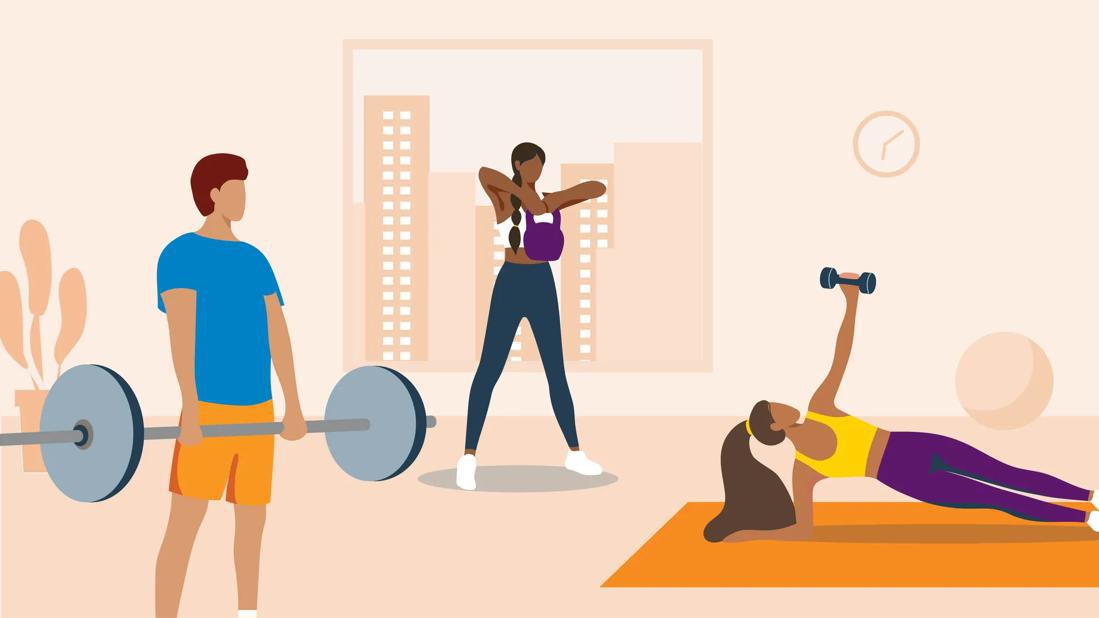Weightlifting 101
Weightlifting can help you build muscle mass, reduce joint pain and increase flexibility to improve your quality of life

Weight training can seem daunting, especially when you’re a beginner. With all the different kinds of weights, machines and movements, it can be hard to get a grip on it all.
Fortunately, anyone can pick up weightlifting, and at any age. You just need to have a solid goal in mind and a little education on proper form.
Exercise physiologist Christopher Travers, MS, breaks down some of the secrets behind lifting weights and how to start a strength training program.
What is weightlifting?
Lifting weights is a form of resistance training or strength training. It helps you build stronger and leaner muscles, which can improve your quality of life by preventing injury and sustaining your ability to do everyday activities.
Weightlifting can involve:
- Body weight
- Traditional free weights or dumbbells
- Elastic resistance tubing
- Weight machines
“With weight training, you’re using your body to move any object of resistance,” explains Travers. “It can be anything. It can be medicine balls or even household objects like soup cans or milk jugs filled with sand.”
As you gain more muscle, you progress your training by increasing the amount of weight, reps or sets of each exercise.
Benefits of weightlifting
Lifting offers full-body benefits that include:
- Increased strength and power
- More muscle mass (hypertrophy)
- Improved endurance
- Increased metabolism and calorie burn
- Reduced joint pain and improved flexibility
- Reduced risk of chronic diseases, like Type 2 diabetes
“As we age, we start losing lean muscle mass, which means our metabolism starts to slow down,” says Travers. “The stronger your muscles are, the better joint health you can have. That allows you to be more mobile as you age and be able to lift and do things you want to do as you get older.”
How to begin lifting weights
With weight training, you want to build a solid foundation and have a clear set of goals in mind for what you’re trying to achieve.
“To build muscular strength, you’re looking at using higher weights and lower ranges of sets and reps,” clarifies Travers. “If you’re looking to build endurance, go with lower weights and a higher number of sets and reps.”
You might have different goals at different times. But for beginners, Travers recommends starting with the following:
- Research science-based recommendations from trusted resources like the American College of Sports Medicine.
- Partner with an athletic trainer, personal trainer or physical therapist for a proper introduction to weightlifting and form.
- Start with body weight exercises or resistance band exercises to learn proper movement and form.
- Aim for two to three total-body weightlifting workouts a week.
- Gradually progress to using machines or dumbbells and free weights.
- Prioritize safety and recovery with warm-ups and cool-downs, and rest for at least one minute between each set to limit risk of muscle strain or injury.
“I always recommend starting with body weight exercises and doing two sets of eight to 15 repetitions for each exercise the first time you’re going through them,” says Travers. “The idea is that you would do those exercises until they become easier for you, and then you would gradually add different exercises, more weights or more sets and reps week after week.”
Under these guidelines, a four-week weight training program might look like this:
Week one
Focus on body weight exercises, with two sets of eight to 15 reps for each exercise:
- Jumping jacks as a warm-up
- Push-ups
- Air squats
- Lunges
- Chair dips
- Planks
- Bridges
Week two
Continue with the same routine as week one, but add resistance band exercises, like:
- Rowing
- Lateral pull-downs
- Triceps push-downs
Week three and four
“Once you’re a couple of weeks in, you can start replacing body weight exercises with weight machine exercises,” says Travers:
- Replace push-ups with a seated chest press or free weight bench press.
- Replace triceps push-downs with dumbbell kickbacks.
- Add in leg curls or leg presses.
"After week four, you’ll continue to progress your weight training and by week six you’ll have a full lifting program established,” he notes.
Weightlifting exercises
“When lifting weights, you want to hit every major muscle group — your chest, back, shoulders, biceps, triceps, core and legs,” says Travers.
Your legs move you every day. In fact, three of your largest muscle groups are in your lower body — your glutes, hamstrings and quadriceps. Keep them strong and you may minimize knee and hip pain.
The same can be said for other parts of your body, too. The more you focus on building strength and muscle in your entire body, the more benefits you’ll discover.
Travers recommends these weight training exercises once you’re in full swing:
- Deadlifts
- Squats
- Bench press
- Dumbbell rows
“The more strength training you do, you increase your lean muscle mass, which in turn helps raise your resting metabolic rate,” he highlights. “That then helps you burn more calories.”